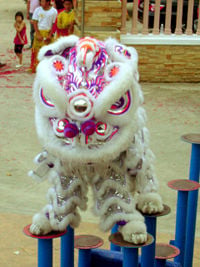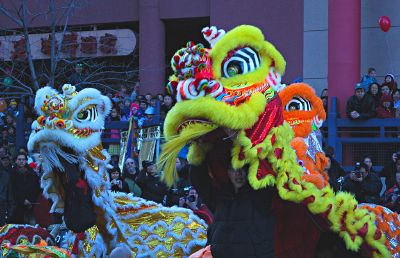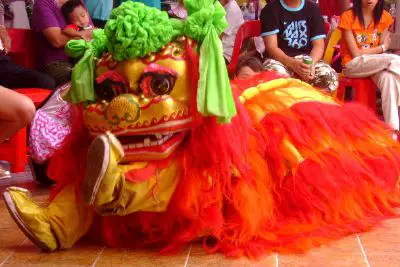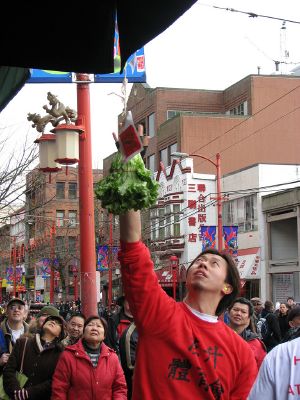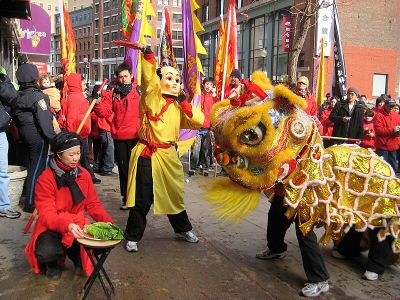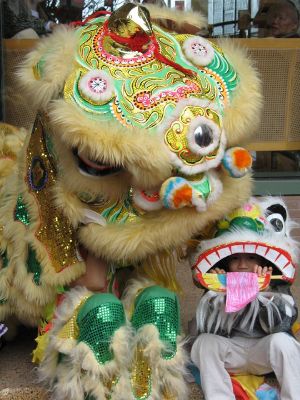Lion dance
| Lion dance | |||||||
|---|---|---|---|---|---|---|---|
| Chinese name | |||||||
| Traditional Chinese: | 舞獅 | ||||||
| Simplified Chinese: | 舞狮 | ||||||
| |||||||
| Japanese name | |||||||
| Kanji: | 獅子舞 | ||||||
| Romaji: | shishimai | ||||||
| Korean name | |||||||
| Hangul: | 사자춤 | ||||||
| Hanja: | 獅子춤 | ||||||
| |||||||
| Vietnamese name | |||||||
| Quoc Ngu: | Múa lân | ||||||
Lion dance (Simplified Chinese: 舞狮; Traditional Chinese: 舞獅; pinyin: wǔshī) is a form of traditional dance in Chinese culture, in which performers in a colorful, articulate lion costume create a ritualized and stylized dance for entertainment and spiritual purposes. The history of the lion dance goes back thousands of years, and many folk tales seek to explain its origin. Because there were no lions native to China when the dance was developing, the local people developed the lion dance by imitating the movements of animals they knew, and two separate styles of the dance developed: A northern style and southern style. The northern style tended to be more explosive, incorporating stunts, while the southern style tended to be more stylized, with less realistic looking lion costumes.
The lion dance continues to be an important part of Chinese culture, and as it has spread around the world with Chinese immigrants, fantastic lions can be seen performing as far away as Mexico and Chile, in Chinese New Year Celebrations, and at many other auspicious events. The lion dance is often confused with the dragon dance, but while the lion requires only two people to operate, dragons require at least three, often as many as ten or more. According to Chinese folklore, the lion brings good fortunes and protection, providing peace of mind for those who cross its path.
History
The lion dance originated in China sometime before the Tang Dynasty (618-907). There has been an old tradition in China of dancers wearing masks to resemble animals or mythical beasts since antiquity, and performances described in ancient texts such as Shujing where wild beasts and phoenix danced may have been masked dances.[1] In Qin dynasty sources, dancers performing exorcism rituals were described as wearing bearskin mask,[1] and it was also mentioned in Han dynasty texts that "mime people" (象人) performed as fish, dragons, and phoenixes.[2][3]
However, the lion is not native to China, and the Lion Dance therefore has been suggested to have originated outside of China from countries such as India or Persia.[4] Because the vast majority of people had, thus, never seen a lion, they based their lion dances on the animals they saw around them.[5]
There were different versions of the dance in the Tang dynasty. In the Tang court, the lion dance was called the Great Peace Music (太平樂, Taiping yue) or the Lion Dance of the Five Directions (五方師子舞) where five large lions of different colors and expressing different moods were each led and manipulated on rope by two persons, and accompanied by 140 singers.[2] In another account, the five lions were described as each over 3 meters tall and each had 12 "lion lads," who may tease the lions with red whisks.[2] Another version of the lion dance was described by the Tang poet Bai Juyi in his poem "Western Liang Arts" (西凉伎), where the dance was performed by two hu (胡, meaning here non-Han people from Central Asia) dancers who wore a lion costume made of a wooden head, a silk tail and furry body, with eyes gilded with gold and teeth plated with silver as well as ears that moved, a form that resembles today's Lion Dance.[2]
In yet another version, an unfamiliar creature rescued the emperor one night when he was lost after a battle, guiding him back to his troops. Describing the animal to his ministers, the emperor discovered that his rescuer was a lion.[5]
The Southern Lion is a later development in the south of China originating in the Guangdong province. There are a number of myths associated with the origin of the Southern Lion: one story relates that the dance originated as a celebration in a village where a mythical monster called Nian was successfully driven away;[6] another has it that the Qianlong Emperor dreamed of an auspicious animal while on a tour of Southern China, and ordered that the image of the animal be recreated and used during festivals. However it is likely that the Southern Lion of Guangzhou is an adaptation of the Northern Lion to local myths and characteristics, perhaps during the Ming dynasty.[7]
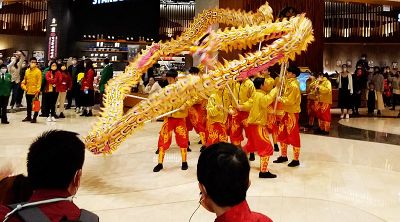
These stories portray the lion as a guardian creature. It is featured in Buddhist lore, with the Bodhisattva Manjusri riding on a lion's back. There are different variations of the lion dance in other Asian cultures including mainland China, Taiwan, Hong Kong, Macau, Japan, Okinawa, Korea, Vietnam, Malaysia, and Singapore, with each region possessing their own styles.
The Lion dance is often confused with the Chinese Dragon dance. However, it is distinguishable from the dragon dance, which is performed by many people who hold the long sinuous body of the dragon on poles, while the lion dance is normally operated by two dancers, one of whom manipulates the head while the other controls the lion's body. Sometimes the front performer stands on the shoulders of the back performer, giving the lion great height. At other times, the lions climb or even jump to the top of tall poles and balance on small platforms at the end of the poles. Chinese lion dance fundamental movements can be found in Chinese martial arts, and it is commonly performed to a vigorous drum beat.
Styles of lion dances
Chinese lion dances can be broadly categorized into two styles, Northern (北獅) and Southern (南獅). Northern (or Beijing) style, lion dances were developed by imitating the movements of a dog, and were performed as entertainment for the imperial court. The northern lions costumes were usually in warm tones, shaggy in appearance, often with golden heads. The northern dance is often acrobatic, incorporating dangerous stunts.
The Southern style lion dances are more symbolic, and is associated with the legend of a mythical monster called Nian. The southern lion exhibits a wide variety of colors and has a distinctive head with large eyes, a mirror on the forehead, and a single horn at center of the head.
Northern Chinese style
Northern lions make life-like movements resembling those of a Pekingese or Fu Dog. Acrobatics are very common, with stunts like lifts, walking on wooden or bamboo stakes, jumping over tables, or balancing on a giant ball.
The northern style lion dance is often performed as a pair of male and female lions in the north of China. Northern lions may have a gold-painted wooden head, and shaggy red and yellow hair with a red bow on its head to indicate a male lion, or a green bow (sometimes green hair) to represent a female. Northern lions sometimes appear as a family, with two large "adult" lions and a pair of small "young lions." The adult lions are typically performed by two people, while the small lions require only one.[8]
The Northern lion dance has a longer history than any other form. It is said that the northern lion may have originated from Northern Wei, when Hu dancers performed the dance for the emperor, and it was referred to as Northern Lion by the Song dynasty.[9]
The northern lion puppet is generally more realistic than the southern lion. The northern lion has a mane and four legs and makes great use of these prancing legs in its performances.
Southern style
The south embraced a more stylized version of a lion, often with only two legs, and a drape over the back. It is normally performed at the Chinese New Year.
The ribbon, along with a mirror used to show the devil his own hideous reflection, date back to the Buddhist story of the lion cast out from heaven. The dance combines art, history, and kung fu moves. The lion's eyelids, head and mouth move, suggesting vitality and longevity, while the tail of the lion sweeps away bad fortune and unpleasant things from last year. A mirror attached to the head of the lion is believed to expel negative energy. Since the negative energy would be reflected backwards, evil spirits would be frightened by their own appearance when looking into the mirror and hence would escape.[10]
When the dancing lion enters a village or township, it is supposed to pay its respects first at the local temples, then to the ancestors at the ancestral hall, and finally through the streets to bring happiness to all the people.
Guangdong is the homeland of the southern, or Cantonese style. The Cantonese style can be further divided into Fut Shan (Buddha Mountain), and Hok Shan (Crane Mountain). There are also combined styles, such as the the Fut-Hok style which combines the Fut Shan Lion Dance and Hok Shan Lion Dance. Similarly, the Jow Ga style uses the combinations of arts and crafts of Hok Shan and Fut Shan.
Fut Shan Lion was the first Lion to be created in China. It has a high forehead, curved lips, and a very sharp horn on its head. This is the style many Kung Fu schools adopt. It requires powerful moves and strength in stance.
Hok Shan Lion incorporates the movements of a cat into the movements of the Fut Shan Lion Dance. The rhythm of the drum beats was adapted to suit these new movements, and the lion head was altered, changing the shape of its mouth, lips, and eyes to make it looks more graceful and elegant.[8]
Different colors are used to signify the age and character of the lions. The lion with white fur is considered to be the oldest of the lions, while the lion with golden yellow fur is the middle child. The black lion is considered the youngest lion, and the movement of this lion should be fast like a young child or a headstrong teenager. The colors may also represent the character of the lion: the golden lion represents liveliness, the red lion courage, and the green lion friendship.
Another group of three famous lion types portray three blood oath brothers, that swore to restore the Han dynasty: Liu Bei, Guan Gong (Cantonese: Kwan Kung), and Zhang Fei. These men represent historic characters in China that were recorded in the classic Romance of the Three Kingdoms.[11]
The Liu Bei (Cantonese: Lau Pei) lion is the eldest of the three brothers and has a yellow (imperial yellow, in fact, as he became the first emperor of the Shu-Han Kingdom) based face with white beard and fur (to denote his wisdom). It sports a multi colored tail which encompasses the colors of the five elements, as it was believed that being the Emperor, he had the blessings of the heavens and thus control of the five elements. There are three coins on the collar. This lion is used by schools with an established Sifu (teacher) or organization and is known Rui shih (Shui Shi) or The Auspicious Lion.
The Guan Gong (Cantonese: Kwan Kung) lion has a red based face, black fur, with a long black beard (as he was also known as the "Duke with the Beautiful Beard"). The tail is red with black trim. He is known as the second brother and sports two coins on the collar. This Lion is known as Hsing Shih (Shing Shi) or the Awakened Lion.
The Zhang Fei (Cantonese: Chang Fei) lion has a black based face with short black beard, culiflowered ears, and black fur. The tail is black with white trim. Traditionally this lion also had bells attached to the body, which served as a warning like the rattle on a rattle snake. Being the youngest of the three brothers, there is a single coin on the collar. This Lion is known as the "Fighting Lion," because Zhang Fei had a quick temper and loved to fight.
Later, an additional three Lions were added to the group. The Green faced lion represented Zhao Yun or Zhao (Cantonese: Chiu) Zi Long. He has a green tail with white beard and fur and an iron horn. He is often called the fourth brother, this lion is called the Heroic Lion because it is said he rode through Cao Cao’s million man army and rescued Liu Bei’s infant and fought his way back out. The Yellow (yellow/orange) face and body with white beard represented Huang Zhong (Cantonese: Wong Tsung), he was given this color when Liu Bei rose to become Emperor. This lion is called the Righteous Lion. The white color lion is known as Ma Chao (Cantonese: Ma Chiu), he was assigned this color because he always wore a white arm band to battle against the Emperor of Wei, Cao Cao, to signify that he was in mourning for his father and brother who had been murdered by Cao Cao. Thus, this lion was known as the funeral lion. This lion is never used, except for a funeral for the Sifu or some important head of the group, and in such cases it is usually burned right after. Even if it is properly stored, it is not something one would want to keep, as it is symbolically inauspicious to have around. It is sometimes though, confused with the silver lion which sometimes has coloring similar to the white lion. These three along with Guan Yu and Zhang Fei were known as the “Five Tiger Generals of Shu,” each representing one of the colors of the five elements.
Choi chang
During the Chinese New Year, lion dancers from martial arts school will visit the store front of businesses to "choi chang" (採青 lit. picking the greens). The business would tie a red envelope filled with money to a head of lettuce and hang it high above the front door. The lion will approach the lettuce like a curious cat, consume the lettuce and spit out the lettuce leaves but not the money. The lion dance is supposed to bring good luck and fortune to the business and the dancers receive the money as reward. The tradition becomes a mutual transaction.
In the old days, the lettuce was hung 15 to 20 feet above ground and only a well-trained martial artists could reach the money while dancing with a heavy lion head. These events became a public challenge. A large sum of money was rewarded, and the audience expected a good show. Sometimes, if lions from multiple martial arts schools approached the lettuce at the same time, the lions are supposed to fight to decide a winner. The lions had to fight with stylistic lion moves instead of chaotic street fighting styles. The audience would judge the quality of the martial art schools according to how the lions fought. Since the schools' reputation were at stake, the fights were usually fierce but civilized. The winner lion would then use creative methods and martial arts skills to reach the high-hanging reward.
Some lions may dance on bamboo stilts and some may step on human pyramids formed by fellow students of the school. The performers and the schools would gain praise and respect on top of the large monetary reward when they did well. Nowadays, performances to attain the red envelope are not as rigorous but lion dance troupes still have the onus of making a good show or face the consequence of an unhappy client.
Other types of "greens" (青) may also be used to challenge the troupe, for instance using pineapples, pomelos, bananas, oranges, sugar cane shoots and earthen pots to create pseudo barriers and challenges. The dance also performed at other important occasions including Chinese festivals, business opening ceremonies and traditional weddings.
The lion dance troupes are sometimes accompanied by various characters such as the Big Head Buddha (Dai Tou Fut), a dancing monk who acts as a comical diversion, sometimes teasing the lion, sometimes leading it with a fan, sometimes interacting with the crowd.[12]
Costume construction
The head of the costume is generally made of light but strong materials, like paper-mache and bamboo, over a frame of wicker or rattan. Modern heads may also use a frame of aluminum or plastic. The heads are then painted different colors, used to signify different characters.[5] The body and tail is constructed of a cloth, attached to the head. The head's eyes, mouth, and ears are all able to be manipulated by the lead dancer.
The lion dance costumes used in celebrations around the world are often made in specialty craft shops in rural China and imported at considerable expense using funds raised through subscriptions and pledges made by members of local cultural and business societies.
Contemporary lion dancing
Lion dancing is becoming popular in the United States, and in other places around the world with large Chinese immigrant populations, especially at weddings, although such performances do not come cheaply.[13]
Both lions and dragons figure prominently in Chinese New Year's Parades as well as many other celebrations throughout the year. They play an important role in such actions as consecrating buildings and temples, business openings, harvests, official celebrations, and religious rites. Lion Dance competitions are held in countries as distant from China as Mexico.[13]
Popular culture
Once Upon a Time in China
Several movies in the Once Upon a Time in China series involve plots centered around Lion Dancing, especially Once Upon a Time in China III and IV.
Jet Li has performed as a lion dancer in several of his films, including Southern style lion dancing in Once Upon a Time in China III, Once Upon a Time in China and America, and Northern style lion dancing in Shaolin Temple 2 and Shaolin Temple 3.
Dancing Lion
A big budget Hong Kong action film featuring Southern style, Dancing Lion was released in Hong Kong on April 26, 2007. Plans for world-wide international release have not been announced. Producers have remarked the film was influenced by the type of Lion Dancing scenes seen in Wong Fei Hong movies by Kwan Tuk Hing, Jet Li, and Zhao Wenzhuo.
Gallery
A Columbia University Lion Dance Troupe performance at MTV Chi Times Square Studio using a silver Chinese lion New York, New York, United States.
Notes
- ↑ 1.0 1.1 Fan Pen Li Chen, Chinese Shadow Theatre: History, Popular Religion, and Women Warriors (John Deutsch Institute, 2007, ISBN 978-0773531970).
- ↑ 2.0 2.1 2.2 2.3 Wang Kefen, The History of Chinese Dance (China Books & Periodicals, 1985, ISBN 978-0835111867).
- ↑ Faye Chunfang Fei, Chinese Theories of Theater and Performance from Confucius to the Present (University of Michigan Press, 2002, ISBN 978-0472089239).
- ↑ Toni Huber (ed.), Amdo Tibetans in Transition: Society and Culture in the Post-Mao Era (Brill, 2002, ISBN 978-9004125964).
- ↑ 5.0 5.1 5.2 Yi Dao, History of Lion Dance. Retrieved August 11, 2023.
- ↑ Dorothy Perkins (ed.), Encyclopedia of China: The Essential Reference to China, Its History and Culture (Facts on File, 1998, ISBN 978-0816026937).
- ↑ Lion Dance China Daily (October 18, 2013). Retrieved August 11, 2023.
- ↑ 8.0 8.1 Differences in the Lion Dance Lion Dance. Retrieved September 4, 2023.
- ↑ Marianne Hulsbosch, Elizabeth Bedford, and Martha Chaiklin (eds.), Asian Material Culture (Amsterdam University Press, 2010, ISBN 978-9089640901).
- ↑ Lion Dance One World Nations Online. Retrieved September 4, 2023.
- ↑ Southern (Cantonese) Lions Shaolin Lohan Pai Lion Dance Troupe. Retrieved September 4, 2023.
- ↑ Joey Yap, The Art of Lion Dance (Joey Yap Research Group, 2017, ISBN 9671303870).
- ↑ 13.0 13.1 Chinese Lion Chinese Historical and Cultural Project. Retrieved September 4, 2023.
ReferencesISBN links support NWE through referral fees
- Chen, Fan Pen Li. Chinese Shadow Theatre: History, Popular Religion, and Women Warriors. John Deutsch Institute, 2007. ISBN 978-0773531970
- Fei, Faye Chunfang. Chinese Theories of Theater and Performance from Confucius to the Present. University of Michigan Press, 2002. ISBN 978-0472089239
- Huber, Toni (ed.). Amdo Tibetans in Transition: Society and Culture in the Post-Mao Era. Brill, 2002. ISBN 978-9004125964
- Hulsbosch, Marianne, Elizabeth Bedford, and Martha Chaiklin (eds.). Asian Material Culture. Amsterdam University Press, 2010. ISBN 978-9089640901
- Hu, William C. Chinese Lion Dance Explained. Ann Arbor, MI: Ars Ceramica with Chinese Performing Arts Foundation, 1995. ISBN 9780893440381
- Kefen, Wang. The History of Chinese Dance. China Books & Periodicals, 1985. ISBN 978-0835111867
- Loh, Pauline. Lion and Dragon Dance in Singapore. World Scientific Pub Co Inc, 2023. ISBN 978-9811260988
- Perkins, Dorothy (ed.). Encyclopedia of China: The Essential Reference to China, Its History and Culture. Facts on File, 1998. ISBN 978-0816026937
- Yap, Joey. The Art of Lion Dance. Joey Yap Research Group, 2017. ISBN 9671303870
External links
All links retrieved March 11, 2025.
Credits
New World Encyclopedia writers and editors rewrote and completed the Wikipedia article in accordance with New World Encyclopedia standards. This article abides by terms of the Creative Commons CC-by-sa 3.0 License (CC-by-sa), which may be used and disseminated with proper attribution. Credit is due under the terms of this license that can reference both the New World Encyclopedia contributors and the selfless volunteer contributors of the Wikimedia Foundation. To cite this article click here for a list of acceptable citing formats.The history of earlier contributions by wikipedians is accessible to researchers here:
The history of this article since it was imported to New World Encyclopedia:
Note: Some restrictions may apply to use of individual images which are separately licensed.
